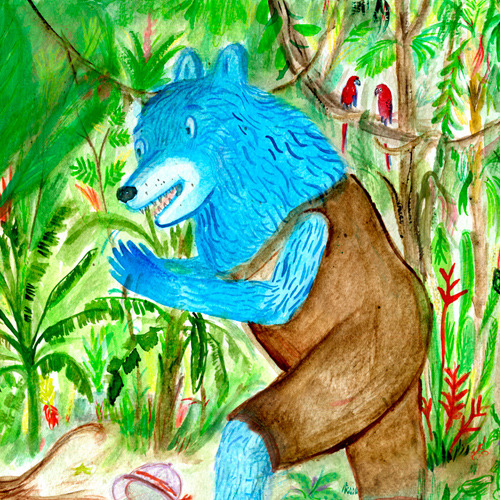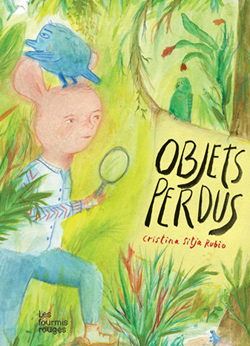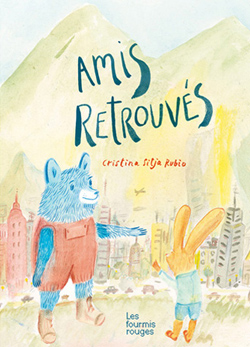< Back to posts
Cristina Sitja Rubio
Venezuela

Cristina Sitja Rubio was born in Caracas and studied Fine Art in Montreal, specialising in printmaking. She later completed an MFA in colour photography, using homemade pinhole cameras. In 2007, she decided to become an illustrator, and has since created a number of successful picturebooks. Cristina lives in Berlin and Barcelona.
In this post, Cristina talks about three fantastic picturebooks: ‘Etranges Créatures’ (Strange Creatures), published by Éditions Notari – plus ‘Objets Perdus’ (Lost Property) and ‘Amis Retrouvés’ (Found Friends), published by Editions Les Fourmis Rouges.
‘Etranges Créatures / Strange Creatures’
Cristina: One day in 2011, I drew a tower of garbage that was transformed into a tree for animals. This was the beginning of the idea for ‘Strange Creatures‘.
I wanted to make a children’s book that dealt with the effect human actions have on nature, but not make it sound as though I was nagging or feeling superior.
When making a book, I rarely make any sketches. I simply dive in to the original drawings right away. Sometimes I will make mini-sketches on the side of the illustration, but will not make any preliminary sketch drawings, enabling them to feel more loose.
The first idea for the book was to use pencil for the animals and collage for the surroundings.
I made four collages and then lost inspiration and left the story for about a month. I then decided to change the aesthetic of the book, and in the middle of the Berlin winter, started on new illustrations, using gouache and watercolours. The results were satisfactory and I continued making spreads for the book, with no written story – just a story in my head.
After making six or seven illustrations, I hit another roadblock and stopped. At this time a friend, Cristóbal León came to Berlin for a visit (May 2012), and when he saw that I had not finished my book, he said he would help me write the text and suggested making a storyboard. So I did. Using Chinese ink, I made very quick and small drawings.
Then we each wrote text to accompany the images and subsequently merged our texts and simplified everything. Cristóbal also helped me change a specific part of the story. In the original version, the animals break into the humans' houses and steal their furniture. Cristóbal told me that it would be easier to just make the animals steal the houses. This is the beauty of children's books: anything is possible.
Extra help came from other illustrator friends who had more experience illustrating children's books. I showed them my illustrations and they gave me tips on how to improve some of them. For example, when the animals go back to their forest and find it destroyed, the original idea was illustrated with a single image. A friend gave me great advice: To create suspense, illustrate the animals looking at something, so the reader will not know what it is until they turn the page.
The illustrations were finished in two months – then the text was polished with Cristóbal, and we came up with a title. The story was originally written in Spanish and English. The title, ‘Extrañas Criaturas’ sounded good, as it did in English: ‘Strange Creatures’. As there was very little text, it was written by hand, which proved to go well with the style of the illustrations.
I had been to the Bologna Children's Book Fair that year and met Paola from Éditions Notari on a bus. The illustrator, Ana Ventura introduced us. I gave Paola a card and she told me to send her something when I wanted.
Well, five months later I had something to send, so I sent Notari and nine other publishers a PDF with the story and the illustrations. Paola called me thirty minutes later and told me she wanted to publish the book! I was so happy, since it was my dream to be published by Éditions Notari.
The process was very quick and the book was published in May 2013. ‘Etranges Créatures’ was selected for the Pepites Awards at the Salon du Livre et de la Presse Jeunesse in Montreuil that same year. Thanks to this exposure, I was approached by other French publishers, and have since published two more titles in French with Editions Les Fourmis Rouges, ‘Objets Perdus’ and ‘Amis Retrouvés’ (I will talk about these books next), and I illustrated another book for Éditions Notari called ‘Octobre’.
After drawing so many bears and pink rabbits, I decided to send them on vacation. So I made a few illustrations with the bears and rabbits in Berlin, Caracas and in the jungle.
‘Objets Perdus / Lost Property’ & ‘Amis Retrouvés / Found Friends’
I created a character in the mid-90s named Cuchuplum. At this time, I was in art school but I had no intentions of being an illustrator. Cuchuplum was just used to illustrate cards, postcards and ceramics for family and friends.
After finishing ‘Strange Creatures’, I was eager to make another book. The characters from that book were still so present in my mind, that the first storyboard had bears and rabbits as protagonists! Then I remembered my father's advice to make a book with Cuchuplum as a main character. I sat down and started making illustrations, and created three characters to accompany Cuchuplum. The story takes place in the Venezuelan jungle, and I drew how the characters met and what they did together. After finishing all the illustrations, I realised they needed text to make the story more comprehensible.
Since I was living in Berlin, I thought the book should be in German, and contacted a German writer to write the text. This was not very successful, so I decided to show ‘Lost Property’ to Valérie from Editions Les Fourmis Rouges during the Bologna Book Fair. There was still no text, but she liked it anyway – as well as the sequel, ‘Found Friends’, which was only a storyboard at that point. Valérie later helped me put together the text for ‘Lost Property’ and ‘Found Friends’. She wrote it in French and sent me PDFs for approval.
Another friend, Laia Jufresa, a wonderful writer, also helped me with the original text for both stories, but unfortunately this was not used. The titles for both books were Laia's idea though, and I am very grateful that she allowed me to use them.
Another drastic change was in the covers. Valérie thought it would be best that the characters appeared on them. Here are the first and final cover illustrations for ‘Lost Property’:
And here are the first and final cover illustrations for ‘Found Friends’:
The result was two simple stories about how some friendships are formed, with a bit of adventure in the process.
After finishing the illustrations for the books, I decided to travel to Venezuela (2014–2015) and go where Coutchuplum (Cuchuplum's name in French) and his friend Oisoletto had gone, and where the other characters, Azur and Lapinito lived. I had been to the Angel Falls a long time ago, but had never walked up to Roraima. It took me one week to go up and down and it was the most wonderful experience. I guess I did the travel research a bit too late, but oh, so worth it!
Hopefully there will be more books about these four friends' adventures in the future. In the meantime, they will keep appearing in my ceramics, prints and drawings.
Cuchuplum and Vogelito (the Spanish name for Oisoletto) will appear this year in another book published by Camelia Ediciones in Venezuela with the title, ‘¿Qué Hacer un Domingo?’ (What to do on a Sunday?). The illustrations were made using drypoint etching and watercolour. The text, as always, came afterwards, again with a little help from Cristóbal León.
All in all, this has been a great experience so far and I hope to continue making picture books with lovely publishers.
Illustrations © Cristina Sitja Rubio.
Etranges Créatures /
Strange Creatures
Cristóbal León & Cristina Sitja Rubio
Éditions Notari, Switzerland, 2014
One boring day in the woods, the animals organise a big party. But afterwards, they discover that all the trees have been cut down by some strange creatures living in a town not so far away. How can the animals fix the situation? It seems hopeless! Eventually, they realise that what's needed here is collaboration.
A beautifully illustrated picturebook about how easy it would be to make our planet safer and happier for everybody if we all respected and took care of nature and listened to others' needs.
Objets Perdus /
Lost Property
Cristina Sitja Rubio
Editions Les Fourmis Rouges, France, 2015
Coutchuplum and Oisoletto live in the city. One day, the two friends pack their bags and fly off in a balloon to live their dream of visiting the jungle. After much exploring, Coutchuplum and Oisoletto fall asleep under a tree, and some thieving monkeys steal their stuff! The pair set off in search of their belongings, and meet Azur and Lapinito, who will become their good friends.
This richly-illustrated picturebook immerses the reader in nature, brilliantly showing the disorientation of the traveller crossing from urban life into the wild.
Amis Retrouvés /
Found Friends
Cristina Sitja Rubio
Editions Les Fourmis Rouges, France, 2016
Azur and Lapinito live in the depths of the jungle. One day, they pack their bags and begin a long journey to visit their good friends, Coutchuplum and Oisoletto in the heart of the city... In the city, everything is amazing and they don't even have bugs or lizards in their houses! The city also offers incredible opportunities and magical places like the movies!
In this second picturebook featuring Cristina Sitja Rubio's four eccentric friends, we all explore the great, colourful, joyous city together.






























